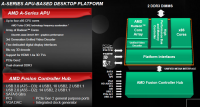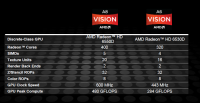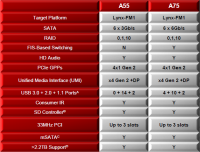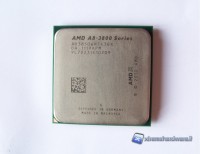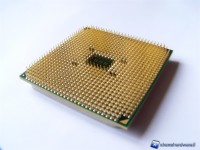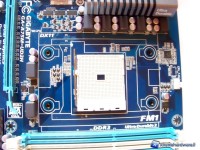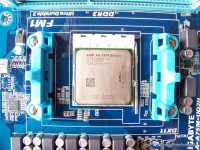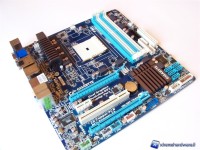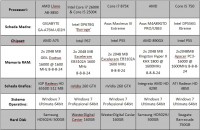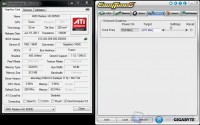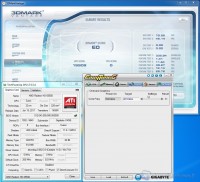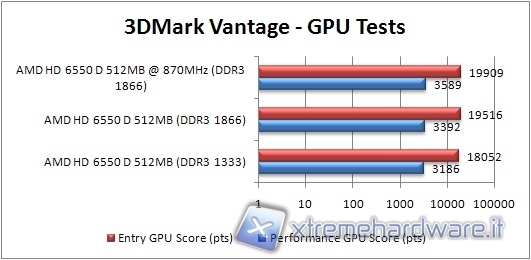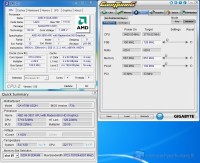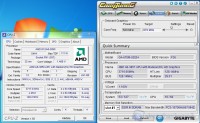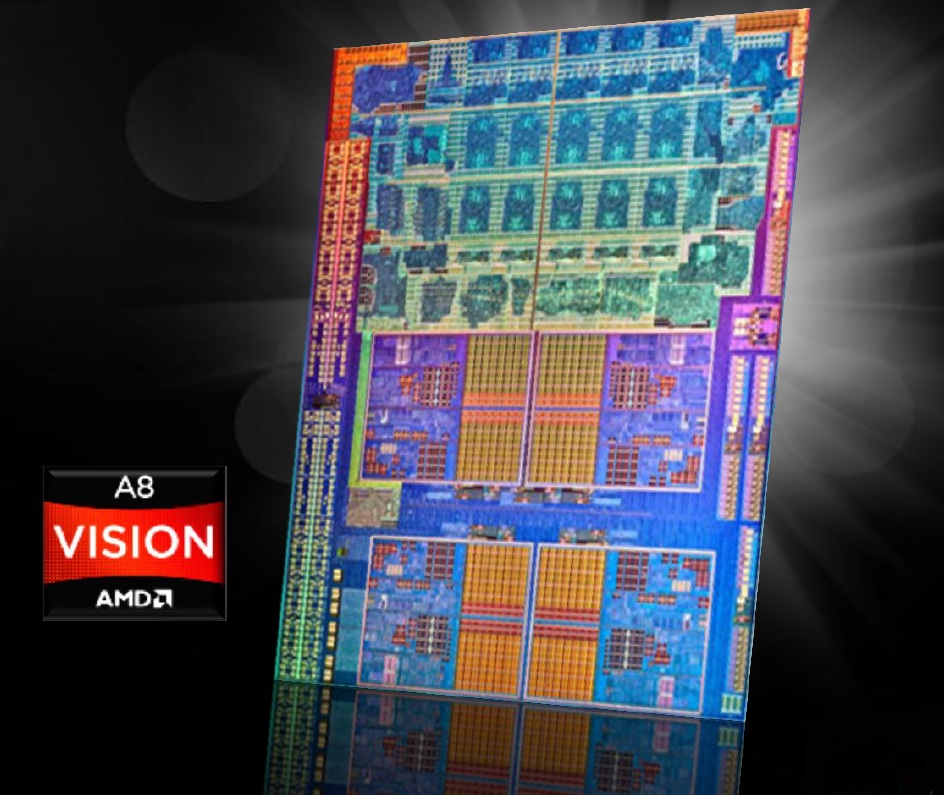
Today AMD introduces the first APU of the Llano family dedicated to the desktop segment. In this article we will present the general characteristics of the architecture and will show you the performance of the current Llano flagship, the A8-3850. In particular, we will show both the computational performance of the CPU, both the excellent performance guaranteed in video games by the integrated GPU.
Overview
In the recent weeks we have had the opportunity to review the Llano architecture at the launch of the mobile platform, code-named Sabine, based on AMD's new APU. At a distance of two weeks AMD also introduces the desktop platforms, code-named Lynx, based on the same AMD Llano architecture. These APUs are the ultimate expression of the AMD Fusion technology, of which we will try to summarize the features in the next pages. In this article we will focus on evaluating the A8-3850 performance. As we will see AMD's goal is to offer a CPU that can meet a wide target audience, getting a good balance between computational and graphics performance. Thanks to the integrated DX11 GPU and numerous features integrated into A75 motherboards, AMD offers a complete Lynx platform of a very low cost. In a future article we will analyze in depth the Llano architecture, analyzing, where necessary even by comparative tests, the improvements over the previous architecture.
AMD Fusion and A-Series APU
The concept of AMD Fusion should now be clear. The purpose of AMD is to "merge" the CPU, GPU and Northbridge in a single chip to reduce energy consumption and production costs while striving to maximize performance for a rather broad target range of users.
This target focuses on displaying information in graphical form, representing the future of the IT world. AMD is committed to providing unparalleled performance in this area, allowing users to benefit from a versatile platform and to meet a wide range of uses.
The slide that illustrates the process of "fusion" leaves us no doubt stunned. AMD has integrated one 66 mm2 chip (the Northbridge), one of 200 mm2 (the quad core CPU) and one of 108 mm2 (a DX11 GPU with 400 processor Stream) in an area of only 228 mm2 of silicon.AMD Alchemy continues in terms of energy balance and TDP, where the Llano APU keep the TDP of the previous quad-core CPU generation, despite the integration of graphics processing units.
Since mathematics is not an opinion we try to explain the AMD Fusion "miracle".First, the main factor that has reduced the occupied silicon area, as well as consumption, is the introduction of the 32nm SOI manufacturing process. It's an important step for AMD that finally manages to fill the technology gap against Intel.
The benefits of switching to new production process are evident. Until now, desktop and mobile AMD CPUs were using the 45nm process, while the GPU were using a 40nm process. Integrating all on a 32nm chip helps us understand the truthfulness of the sum presented in the AMD slide. The efficiency improvements are significant also in relation to the previous E series Zacate and Ontario APU, which adopt a 40nm manufacturing process, derived directly from the GPU. In addition, the cores have been completely redesigned with the goal of energy saving by turning off unused portions at any time, optimizing the layout of the clock circuits and implementing various deep off states of cores. All of this extended to other parts of the chip, as the GPU, northbridge and UVD unit.
Obviously there's more. Comparing an Llano APU to a quad-core Intel Sandy Bridge we can not do nothing but notice the lack of L3 cache, the supporting heart of the Sandy Bridge architecture. AMD has chosen to increase up to 1MB the L2 cache compared with only 256KB of Intel's.Instead there is no shared cache between cores and IGP. The elimination of L3 cache leads to a significant savings in area and the ability to deploy advanced energy-saving states, that with the unique architecture of the AMD cache, would have been costly and inefficient to implement, for the benefit of graphics processing units.
Analyzing the percentage by which they divided the two CPUs (APU and SB) we can clearly see how much silicon has been reserved in the APU for the graphics unit of AMD. Almost twice as used by Intel, coming to occupy almost one third of the entire die.In the picture we see distinctly 5 SIMD engine at the top of the die, while below are the 4 x86 core with its L2 cache.
The 5 SIMD engine have 80 stream processors each, for a total of 400 stream processors. It's a very large number, superior even to the Caicos GPU that equips the HD 6450, entry level in the desktop market. It's in fact very close to the stream processors number composing an HD 6570 or HD 6670 that integrates 6 instead of 5 SIMD engines present in Llano APU.
Obviously, the IGP has at least one disadvantage over a discrete video card: the lack of dedicated memory. The graphics core of the Llano APU must in fact go to the system RAM, the same which needs to access the CPU. This involves slow access compared to an onboard memory, especially given the lack of an L3 cache that can serve as a common buffer. AMD has tried to balance this disadvantage trying to support memory at higher frequencies than for example the Zacate APU, raising the supported clock up to DDR3-1866.
But one interesting feature of the Llano APU is the Dual Graphics, a CrossFire technology improvement, which takes into account the relative power of the GPUs. In addition, the drivers are optimized for the OpenCL, using the integrated GPU for the less burdensome calculations if the discrete one is processing heavy 3D loads. As an alternative to DualGraphics, the PCI Express link can be configured as additional video outputs to implement the Eyefinity technology in a more advanced configuration.
Llano Architecture in detail
As explained above, within an Llano APU there are up to 4 x86 processor core, and up to 400 stream processors, divided into SIMD Engine of 80 stream processors each. CPU and GPU share access to the DDR3 memory type through a high-performance integrated memory controller. The integrated controller has been improved in the management of data transfers, prefetching algorithms and in the maximum RAM frequency supported, which arrives at 1866 MHz and the presence of a 128-bit dual-channel bus was confirmed.
The APU also features a type 3 UVD video decoder which has already been extensively discussed in other reviews, a PCI Express 2.0 x16 controller, and the management of the display via HDMI 1.4a, DVI and Display Port. The APU is also connected via the Unified Media Interface bus to the Hudson Fusion Controller Hub (FCH) who is in charge of management of peripheral I/O.
Among the most interesting features of the D3 Hudson chipset we find support to next generation standards with up to 6 6Gb/s SATA ports (with the possibility of RAID 0 and 1) and up to 4 USB 3.0. It also manages 10 USB 2.0, 4 PCI Express x1, HD Audio chip and PCI interfaces. We will see in detail the features of this chipset.
Regarding the details of the Llano APU x86 Core there are no easily visible news. The basic architecture is the "Stars" type core, but with some improvements that result in an average increase of 6% compared to the Propus core IPC: the doubling of L2 cache per core, now 1MB, and the use of 8 transistors cells only for L1 data cache, faster, more reliable and able to operate at a lower voltage and therefore less power hungry, the increase of the various internal queues (of the instruction control unit, of the integer, floating point and memory instructions) the improvement of the integer multiplier and the integration of a very efficient integer divider, the increase of Translation Lookaside Buffers for the virtual memory management and improvement of the memory controller, in particular in transfer rate and prefetching algorithms. In addition TurboCore technology has been upgraded to version 2.0, with a better estimate of the instantaneous power absorbed and the precise balance of power between GPU and CPU.
We can not expect great performance at a computational level from the Llano CPU Core, because we start from the performance of the Propus core. However, the presence of a very large number of Stream Processors on the paper makes an Llano APU the most powerful APU ever made in terms of GFLOPS. In addition, the zero copy and Pin In Place technologies, offer a substantial improvement in the memory performance, compared to an IGP and also compared to a discrete graphics card. These technologies allow the GPU to directly use the data in main memory, without having to go through the PCI Express bus, as in the past. The power offered by AMD SIMD can be exploited, however, only by those applications that take advantage of GPU acceleration. To that end, AMD is working closely with many software companies, to allow users to exploit this untapped potential in an efficient manner.
A8 and A6, four debuting APU
Today four APU for the desktop segment, two A6 and two A8, are introduced. Each APU is also marketed under two different TDP: 100W and 65W, the first with higer, but fixed, CPU operating frequencies, and the second with lower frequencies but that can be increased through TurboCore 2.0 technology. A8 and A6 are both equipped with 4 cores: the different numbers refers to an increased number of stream processors, 400 for the A8, compared with 320 of the A6. All APUs have 4MB of L2 cache, support 1866 MHz DDR3 memory and can be installed on platforms with FM1 Socket.
By analyzing in detail the two HD 6550D and HD 6530D GPU, respectively integrated in the A8 and in the A6, we note first of all the different number of active SIMD, 5 for the first and 4 for the second. Since each SIMD has 80 stream processors, organized with VLIW-5 architecture, the total number of stream processors is 400 for the HD 6550D and 320 for the HD 6530D. With 4 texture units per SIMD varies of course also their total number in the two GPUs, 20 and 16, respectively. In the A6 the working frequency was also reduced, from 600MHz to 443MHz. Overall, this results in a significant reduction of computational power of the GPU, which is almost halved. The number of ROPs remains unchanged and is equal to 8 for both GPUs.
A75 and A55, two FM1 socket platforms
Lynx platforms will be marketed under two names: A75 and A55. These two acronyms are adopted by all motherboards and chipsets manufacturers and differs for the adopted chipset (Fusion Controller Hub or FCH). Indeed we have the D3 Hudson and D2 Hudson FCH that fit respectively to models A75 and A55. The main differences between the two platforms affect the the latest generation interfaces, 6Gb/s SATA and USB 3.0. While the D3 Hudson chipset (A75) has well 6 6Gb/s SATA and 4 USB 3.0, in the other none of the other new standard is supported, the user will have to settle for 3Gb/s SATA and USB 2.0, unless taking third party controllers solutions. The integrated USB 3.0 controller in the chipset is a big step forward compared to current technologies. Until now, all motherboard manufacturers have had to use third party controllers from NEC, or Etron, with performance and cost often unpromising. AMD has integrated for the first time both the 6Gb/s SATA, both the USB 3.0 inside of its chipsets in order to ensure a high level of connectivity at an affordable price. The target price of these motherboards with A75 chipsets is in fact less than 100 Euro.
As for the SATA connections, both chipsets implement RAID 0, 1 and 10.
A8-3850: technical specifications
After introducing the architecture of the new Llano processors and chipsets that will support this technology, we go to the description of the product thanks to data collected by some of the most popular commercial software.
The tests will be made on the model available to us, the A8-3850. Currently, this CPU is the flagship of the solutions proposed by AMD, which is available at a price of € 129.99. This model operates at a standard frequency of 2.9GHz, while the integrated GPU is a Radeon HD 6550D with 400 stream processors clocked at 600MHz.
In the second image we can see the 905-pin going to fit into as many holes in the FM1 socket.
Here are the data recorded on the CPU through the known CPU-Z software, updated to version 1.58, that can provide full recognition of the new architecture and new Llano processors.
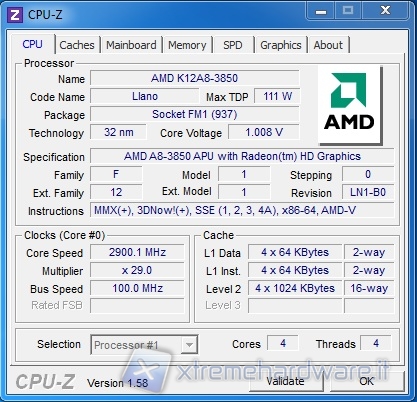
In the first screen we see all the information about the CPU itself, beginning with the name "K12A8 AMD-3850", ending with a frequency of 2900 MHz, obtained by multiplying the x29 system bus operating at 100 MHz. Note how the software recognizes 32 nm technology and specify that this model is equipped with integrated GPU; it is identified by the heading "Specification: AMD A8-3850 APU with Radeon HD Graphics." The only mistake we can note is the detection of the socket to which they belong, right in the name "Socket FM1" but wrong in the pin number, 937 instead of 905.
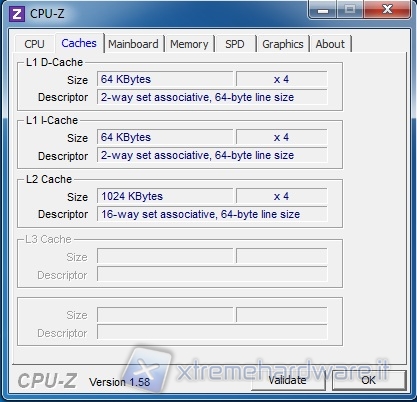
The second "tab" contains information regarding the amount of cache inside the processor. We found the lack of third level cache and the L1 data cache amounts to 64KB per core; the same amount we find in the L1 instruction cache. The L2 cache is larger than the Phenom II CPU, and is equal to 4 MB, 1024KB per core.
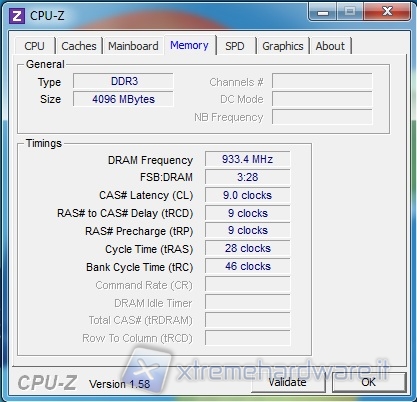
This screen shows the data on the amount of memory installed, the frequency and the setted timing. In our case, the RAM has been set to a frequency of 1866MHz, supported by the new A8-3850, with 9-9-9-28 timings.
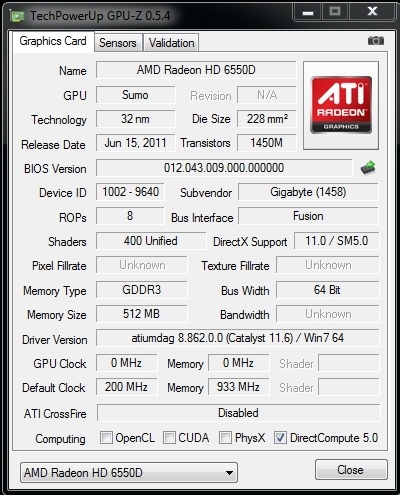
In this image taken from GPU-Z are summarized the main features of the integrated GPU in AMD A8-3850. The software, updated to the latest version, recognizes the GPU and the 32 nm manufacturing technology.
In addition to such information, it reports the number of shaders in this model, 400, the amount of RAM to use, stealing it from system memory, 512 MB in this case (value set from bios) and the rate at which it operates, 1866 MHz (933 x 2).
Other information regard the size of the die, amounting to 228 sq mm and the number of transistors, 1450 millions. The only wrong value that the software reports is the operating frequency of the GPU core, indeed GPU-Z shows 200MHz, while the standard frequency is equal to 600MHz.
As already mentioned, the AMD A8-3850 is the flagship model of the A-Series produced by AMD and as such features the most powerful integrated GPU.
Gigabyte A75M-UD2H
The motherboard provided along with the A8-3850 is a GIGABYTE GA-A75M-UD2H equipped, of course, of the FM1 socket that can support all the Llano processors on the market today.
This Micro ATX mainboard is equipped with AMD A75 chipset and is capable of supporting up to 32GB of DDR3 RAM; let's specify that it is possible to run the memory at 1866 MHz only if there are only two banks installed, because there is not support for four banks operating at 1866 MHz
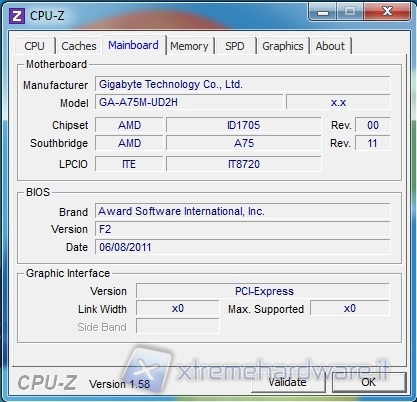
Among the expansion slots are:
- 1x PCI Express x16
- 1x PCI Express x1
- 1x PCI Express x16 slots running at x4
- 1x PCI slot
The GA-A75M-UD2H has 5 6 Gb/s SATA connectors, capable of supporting RAID 0, RAID 1, RAID 10 and JBOD, plus a 6 Gb/s eSATA port on the rear panel.
Below is a list of I/O connections on the rear panel:
- 1 x PS / 2 keyboard / mouse port
- 1 x eSATA 6Gb / s
- 1 x DisplayPort
- 2 x USB 3.0/2.0
- 1 x DVI-D
- 1 x HDMI port
- 1 x D-Sub
- 1 x SPDIF out (optical)
- 6 x audio ports
- 4 x USB 2.0/1.1
- 1 x RJ45 LAN
For more information about this model, we refer directly to the manufacturer's website:
http://it.gigabyte.com/products/page/mb/ga-a75m-ud2hrev_10/specs/
System and testing methodology
Here are the tables containing the technical specifications of the system used to perform the processor tests.
The tests were conducted on both the processor and on the GPU, using, for the latter, the RAM set both at 1333 MHz and at 1866 MHz, to detect any benefits from the maximum frequency supported by the processor and in this case also by motherboard. The CPU has been left to the standard frequency of 2900 MHz and compared with other AMD products and from competing solutions from Intel.In this case, the RAM has been set at a frequency of 1600 MHz CL8.
Following are the software used for CPU testing:
SYNTHETIC
3DMark Vantage: produced by Futuremark, 3Dmark Vantage is a useful tool to test the performance of your system.Primarily designed to track the performance of the graphics card, the 3DMark Vantage is suited for testing of the CPU that are increasingly a bottleneck in the system when it comes to graphics applications. The test was carried out only in relation to the CPU, disabling the 2 steps related only to vga.
PCMark Vantage: Another famous benchmark produced from Futuremark that has the task of analyzing the performance of the entire system.The tests made are CPU-related and include: data encryption, decryption, compression, decompression, image manipulation through the CPU, audio transcoding, video transcoding, and many other tests.
AIDA64: AIDA64 is a software product from FinalWire that monitors the system by providing detailed information on hardware components.The software includes a utility inside the bench capable of testing memory and cache inside the processor.
Passmark Performance Test 7: another application able to obtain detailed information about system hardware.It includes several benchmark utilities subdivided for each component. In this case, the tests were performed on the CPU and include the integer calculations, floating point calculations, tests of the SSE instructions and many others.
DATA COMPRESSION AND MULTIMEDIA
7zip 9.20: this well-known archive software contains within it a tool that can analyze system performance, reporting a value expressed in MIPS (million istruction per second).The tests include compression, decompression, and overall value.
Winrar 3 Beta 4: Another famous compression and decompression software for data archives.Inside it there is a benchmark utility that compresses a standard file suitable for this purpose; the software will return the compression speed in KB/s.
Cinebench 11.5 and 10: Software products from Maxon that allow, through the development of three-dimensional images and content, to test the CPU performance. Both the release allow to test the CPU using a single core, or all the cores inside the processor.
X264 HD Benchmark 3.0: software to measure the performance of the CPU using the x264 video encoding.
Handbrake 0.9.5: Multi-threaded video encoding software with which we will transform a file (a movie) to MP4; the process includes x264 video encoding, FAAC audio encoding and muxing into final MP4 container.The time it takes for the CPU to perform this task will be taken into consideration.
Synthetic tests
3DMark Vantage
We begin our tests starting from the benchmark produced by Futuremark, 3DMark Vantage. The test was done by selecting only the two-step related to the CPU and the performance preset setting.
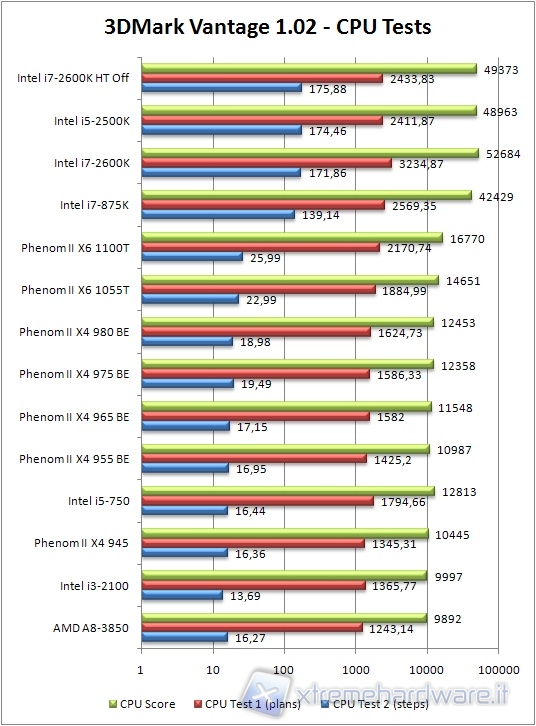
The new CPU manufactured by AMD goes in the last place not far from Intel's i3-2100. In all three results, the A8-3850 is lower than the Intel counterpart performance and the "older" quad-core and hexa-core AMD solutions.
PCMark Vantage
We continue with the other benchmark from Futuremark, the PCMark Vantage. In this case we have selected only the PCMark Suite.
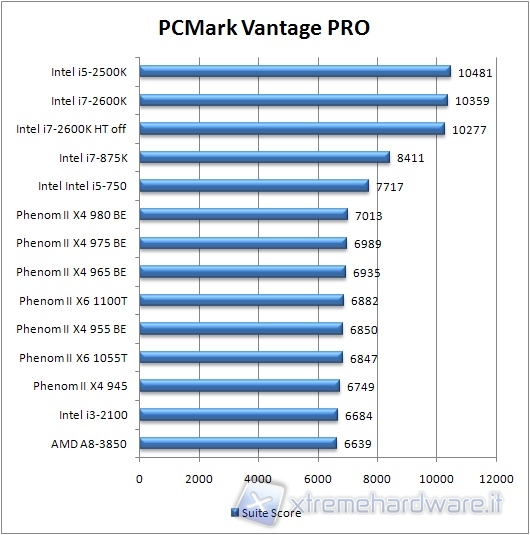
Also in this Futuremark benchmark the new A8-3850 Llano processor gives the lowest value, being very close to an Intel i3-2100, separated by a handful of points.
AIDA64 EXTREME ENGINEERING
Moving on to FinalWire software.
We launch the benchmark related to memory and cache, noting that with regard to latency, a lower value equals better performance.

We begin by analyzing the memory and cache read speed data. In this case, the new AMD is positioned about mid-table, giving a good result on the read speed of memory and L1 cache. As we see the third level cache result is not present because not present in this processor. Good also the memory read value due to higher operating frequencies than previous AMD CPUs.

Let's move to data writing in memory; even in this case, the A8-3850 is positioned in mid-table and is faster in memory writing of other AMD and Intel solutions.
The figure in the cache writing, however, is inferior to other solutions.
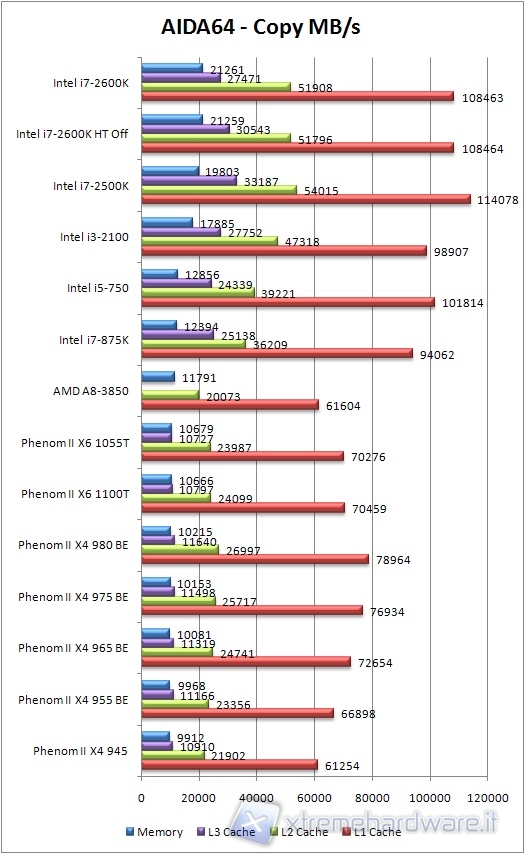
Moving to the copy test; as in previous cases the AMD A8-3850, operating at a frequency of 2.9 GHz, is positioned in mid-table giving a good result for the copy in memory.
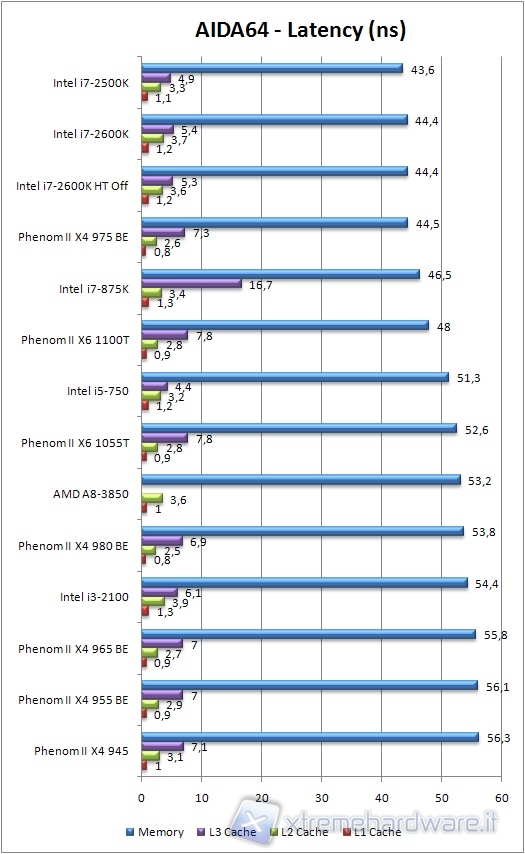
Finally the test on latencies expressed in nanoseconds; here the AMD A8-3850 is more powerful than many solutions of both companies.
PassMark Performance Test 7
Let's launch the CPU benchmark utility inside the Passmark Performance Test and analize the data obtained.
We begin to analyze the data starting with the "CPU Mark"; the new AMD A8-3850 is ranked fourth, leaving behind even the AMD Phenom II X6 1100T, the jewel of AMD.
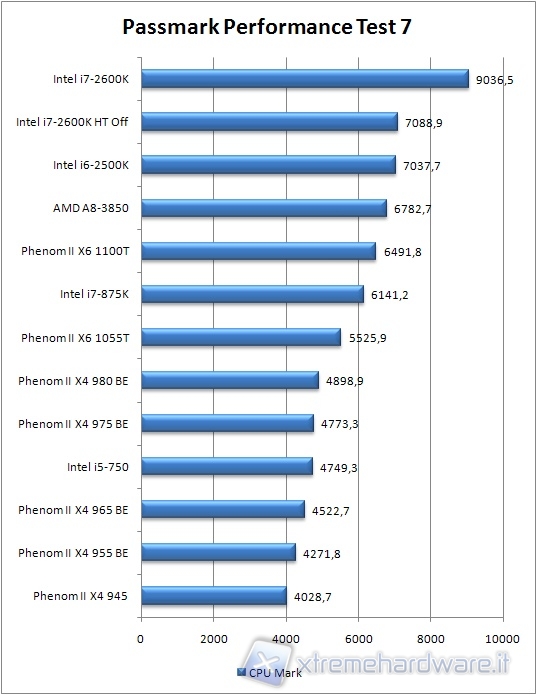
In the immediately following graphs, those relating to floating point and integer calculations and prime number search the AMD A8-3850 is positioned at the top by giving high rate concerning the search of prime numbers and integer calculations; this solution is only surpassed in floating point calculations.
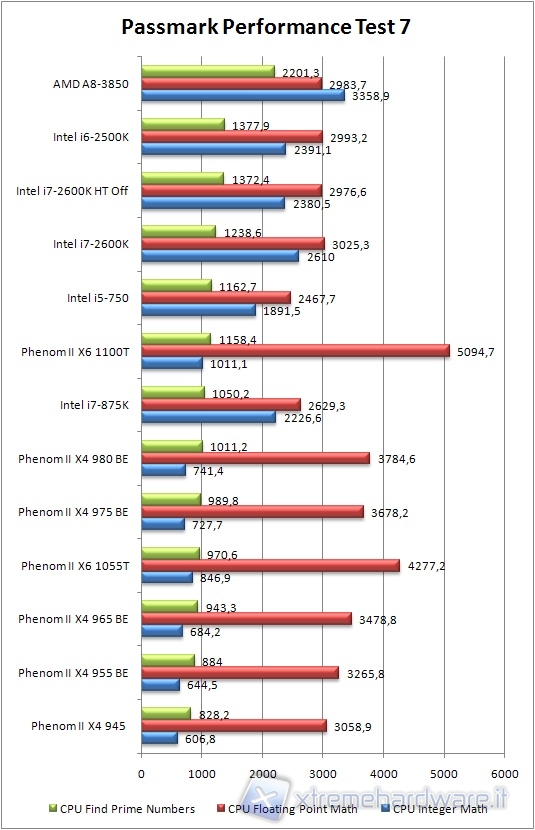
Looking at the graph on the physics calculation, the string-sorting and data compression as well as that of CPU Encryption and SSE we note that the AMD A8-3850 is placed in last place, indeed in this case all other solutions are found more efficient.
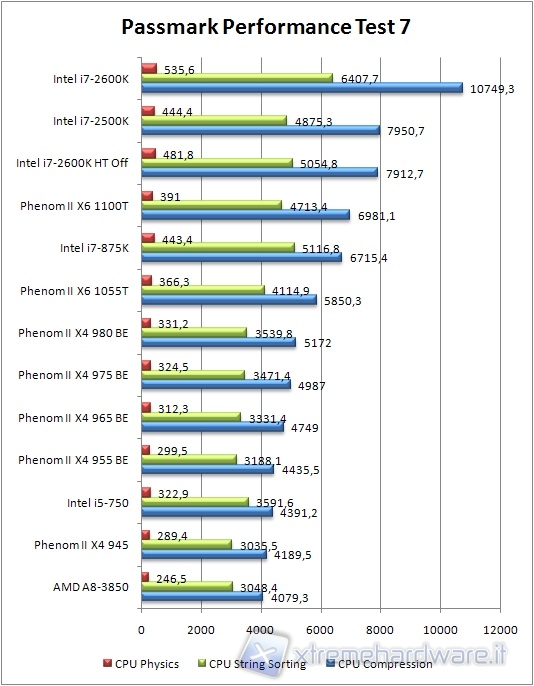
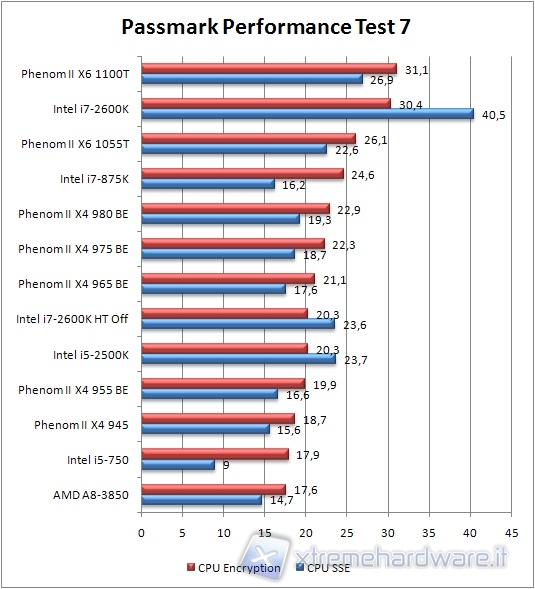
Data compression & Multimedia Test
7zip 9.20
Let's move to the benchmarks related to compression, decompression and multimedia files from a known program to manage archives: 7zip.
Let's launch the tool of performance measurement and verify the values, expressed in MIPS, the software reports.
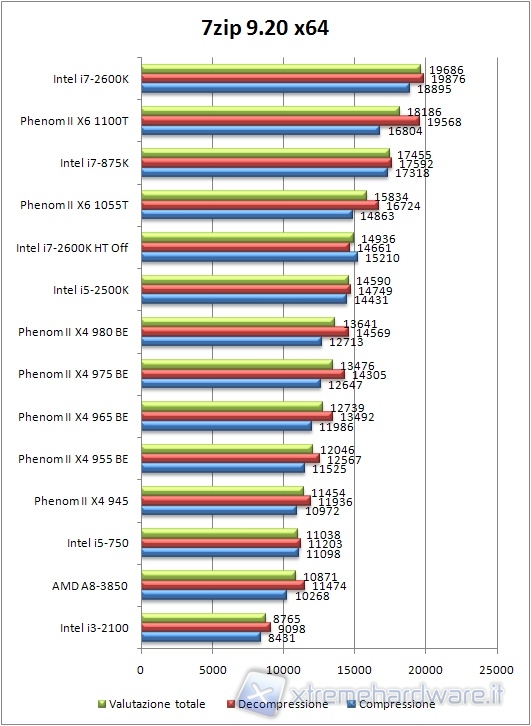
The AMD A8-3850 is ranked second-last between Intel i5-750 and the Intel i3-2100, which occupies the last position.
Looking at the results we see that during decompression this CPU shows a value higher than that found by i5-750.
WINRAR 4 Beta 3
The Winrar benchmark consists of the compression of a software predefined file, reporting a value in KB/s.
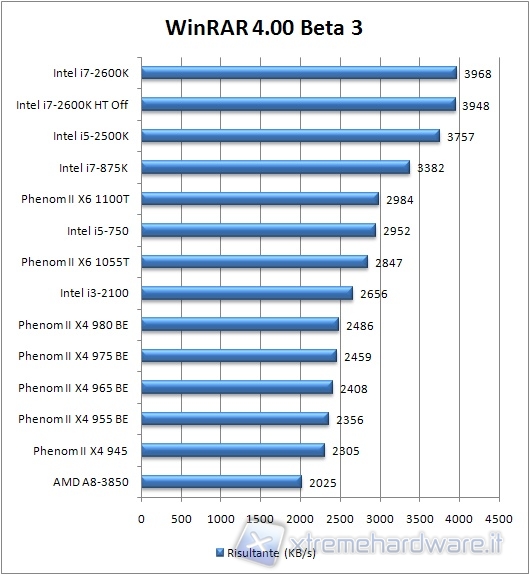
In this benchmark the new AMD holds the last position recording a value well below counterparts.
CINEBENCH 11.5
Let's launch Cinebench 11.5, able to test the performance of a CPU by handling and processing of images.
This software, as well as version 10, is highly parallelized and takes full advantage of all processors in the system.
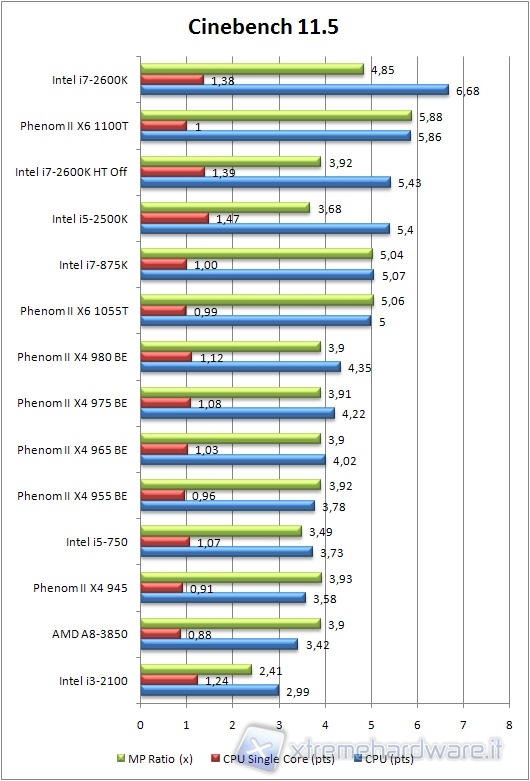
The new CPU occupies the secondlast position not much far by AMD Phenom II 945, quad-core processor operating at 3.0 GHz
CINEBENCH 10
Also this benchmark uses full multicore technologies.
Let's analyze the recorded data.
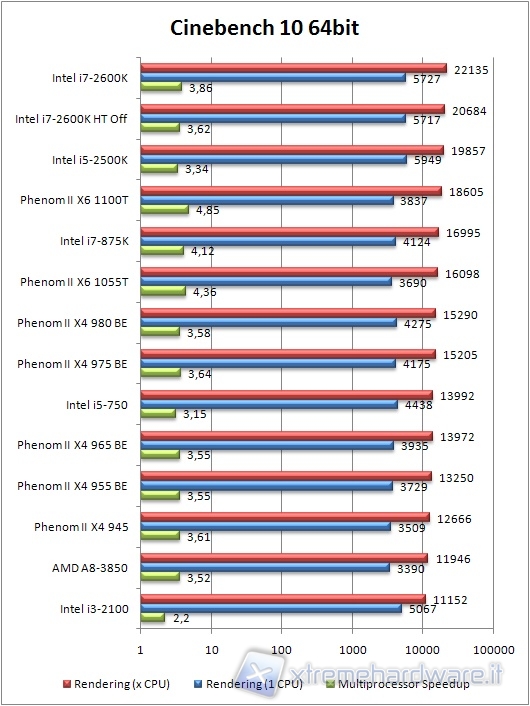
Even in this case, the A8-3850 occupies the secondlast position betweer the Intel i3-2100 and the AMD Phenom II 945.
X264 HD BENCHMARK
This benchmark enables the assessment of performance by converting a chosen file in the x264 format.
This operation is carried out in four phases by two steps each.
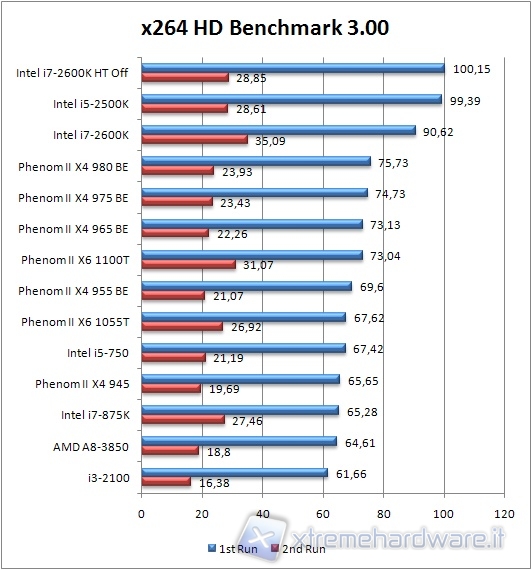
As in the previous test the new AMD solution occupies the secondlast position by giving the average of 64.61 FPS in the first run and 18.8 in the second run.
HandBrake
Let's launch Handbrake with the task of transforming a 698MB MP4 movie verifying which processor needs less time to complete the operation; in this case a lower value on the graph indicates a superior performance.
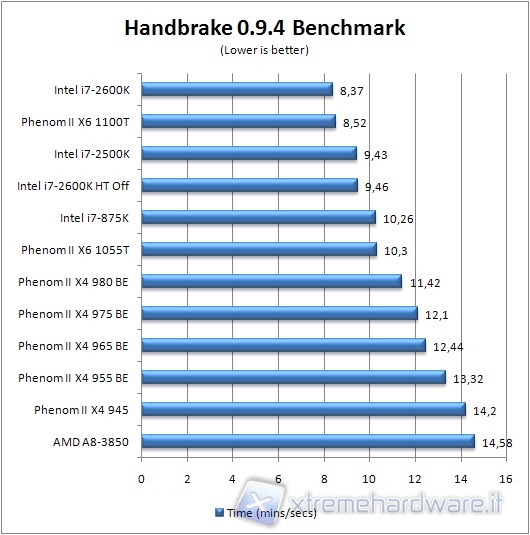
In this test, the AMD A8-3850 took more time than the other processors to convert the file to MP4.
His performance is still very close to that recorded by AMD Phenom II 945.
Considerations on CPU test
Compared to the tested processors the A8-3850 is usually positioned just below a Phenom X4 II with similar frequency, against which benefits of a larger quantity of L2 cache (an advantage in some applications), but the lacks of the L3 cache, often a penalizing factor. Compared to the Intel counterpartit is placed just above to a dual core Sandy Bridge without HT. As expected the A8-3850 CPU computational performance are not exceptional, but are aligned with those of the previous generation despite the lack of L3 cache and slightly lower frequencies. As we will see in the following tests, the strength of Llano is the integrated GPU.
GPU Test
Having analyzed and reported on the CPU tests let's move to those relating to the integrated graphics, the 6550D Radeon HD IGP.
The tests were carried out by setting the memory frequency on 1333MHz and 1866MHz.
Synthetic tests: 3DMark Vantage
Synthetic benchmark developed by Futuremark, necessarily requires the presence in the system of a video card with support for DirectX 10 API and a Windows Vista or 7 operating system. The benchmark consists of 6 separate tests: 4 focused on the GPU and 2 on the CPU. The tests are performed in up to 4 presets configured by Futuremark, characterized by a different level of workload in order to better reproduce the typical scenario of use of your system depending on the hardware configuration in use. The software allows you to set the Entry, Performance, High and Extreme configuration. The tests were done only in Entry and performance mode.
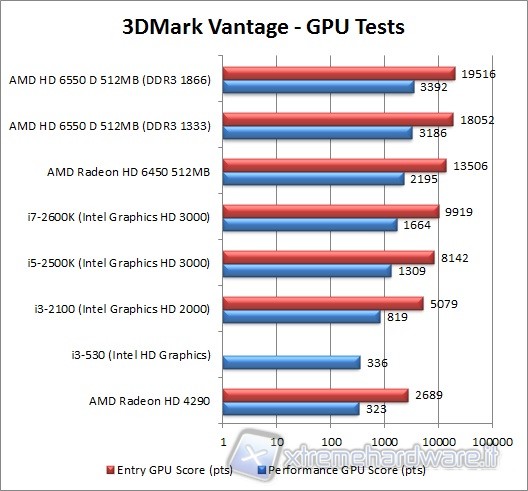
As expected the integrated GPU set the maximum value both with the RAM at clocked 1333MHz that at 1866MHz.
The gap with the HD 6450 discrete graphics card, which earns the third place is marked.
Graphic tests: STALKER, Lost Planet 2
S.T.A.L.K.E.R.: Call of Pripyat
STALKER: Call of Pripyat is a first-person shooter of post-apocalyptic science fiction genre, developed by GSC Game World and published October 2, 2009 (February 5, 2010 in Europe).It is the third installment of the series and is placed chronologically after the events of STALKER: Shadow of Chernobyl, the founder of the saga. STALKER: Clear Sky, the second chapter, is the prequel. Like the previous ones, STALKER: Call of Pripyat was developed with the proprietary engine X-Ray. A group of Stalkers reached for the first time the central core of the entire Zone, the Chernobyl Nuclear Power Station.The already harsh situation in the area is complicated and there is a real risk of a catastrophe. A great power is abnormally changing areas, there are still areas to be considered safe, but for most the whole area is now full of strange anomalies. Many of the Stalkers and the other inhabitants of the area have died as a result of these changes, while new areas appear anywhere in the territory. The area is now very unstable, what to do to stop the anomalies? The game supports DirectX 10.1.
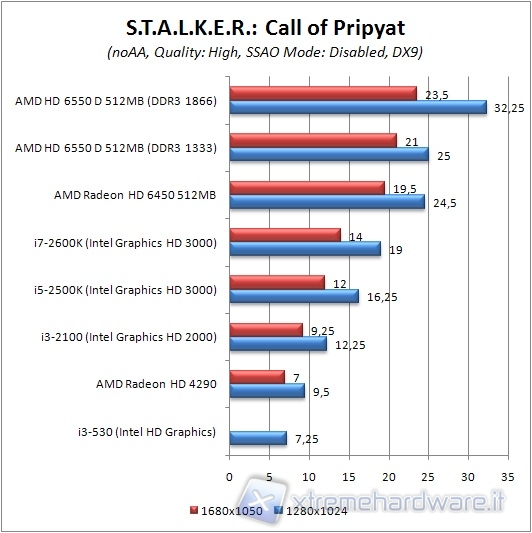
The AMD HD 6550D is faster than the counterpart giving higher levels than any other integrated cards.
The 1866 memory has a serious impact on performance at 1280x1024 resolution.
Let's see instead the results recorded by running the benchmark using DirectX 10.
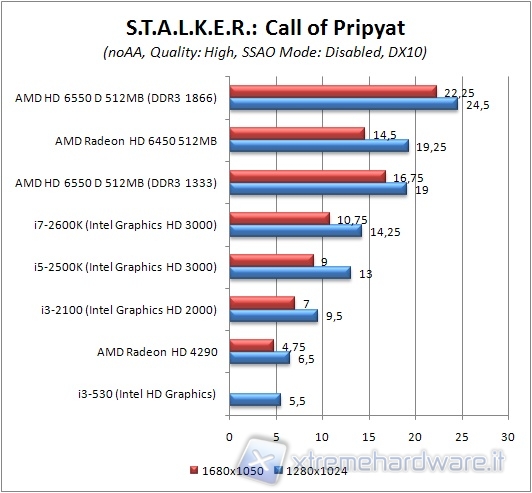
In this case the difference is even more pronounced, because the memories at 1866MHz increases the performance in the range of about 8 FPS at 1680x1050 resolution.
Lost Planet 2
Lost Planet 2 is a game produced and developed by Capcom and released from Halifax for PS3, Xbox 360 and PC. It was initially to be released in early 2010, but Capcom has put off the end of 2010. The game is set 10 years after the adventure of Wayne Holden on Lost Planet, and things have changed: Thanks to the efforts of Wayne and his friends, EDN III, the planet where the game is played, began a slow terraforming process, which has caused a drastic climate change. In fact, if in Lost Planet 1, the planet was only arctic, there are now desert areas, areas with dense tropical jungles, areas with warmer climates, etc.. But this has not brought peace, indeed, now that the world is more populated by humans, they are again divided into bands and real snow pirate clans involved a constant and perpetual civil war for control of the planet and the EN-T, the liquid substance used by humans as fuel for their technology, both from the Akrid, the indigenous creatures of EDN III, which are a perennial problem for humans as they are very aggressive and difficult to kill.
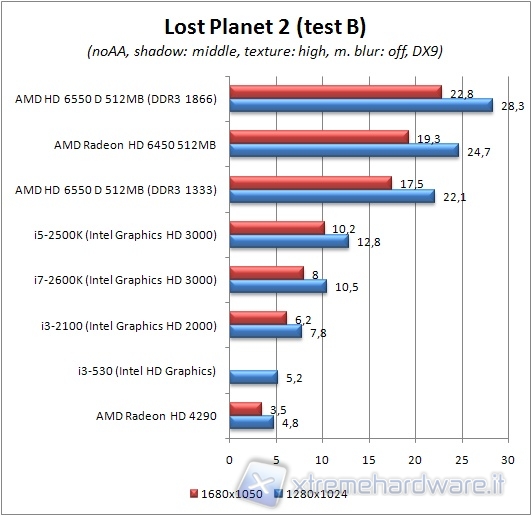
Also in this case, the data speak for themselves, the IGP integrated into the A8-3850 recorded good values earning the podium both with the memory at 1333MHz and at 1866MHz.
Note how the gap with the solutions offered by Intel is very marked and leave no doubt as to which solution is most efficient.
Graphic tests: HAWX 2, DiRT 2
HAWX 2
Tom Clancy's H.A.W.X. 2 ("High Altitude Warfare Experimental") is the second version of flight simulator developed by Ubisoft Romania available for PC, Xbox 360, PlayStation 3 and Nintendo Wii. During the action, the pilot has available several new features over the previous version: night vision to conduct attacks in stealth mode, anti-radar pod that distracts an opponent and prevent him from attacking, the ERS (Enhanced Reality System), which traces a route through virtual dangerous traits in a safer manner. It can also make new flight procedures such as takeoffs and landings from marine platforms and aircraft carriers, air refueling, using bombs and missiles and precision guided. Several missions also provide support to allied units, land, sea and sky. The game has different views: in the first and third person view cabin (with realistic instrumentation), battle-mode plane (third-person view on the battlefield). The pilot data are maintained during all phases of the game, statistics, performance, and can present experience, as well as upgrades and aircraft unlocked (PEC rewards - Persistent Elite Creation). The satellite information, aerial and geospatial data in the game are provided by GeoEye.
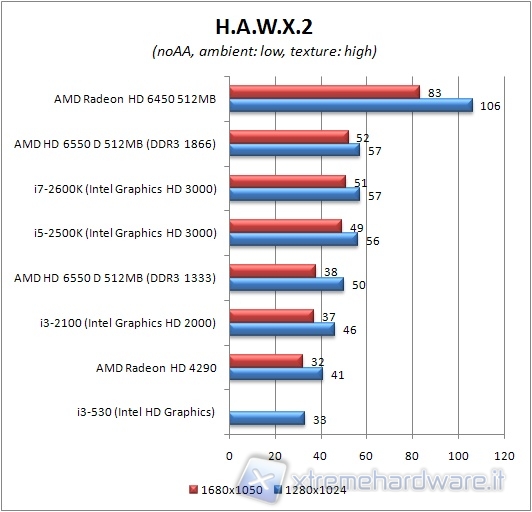
In this case, our HD 6550D is ranked second by registering results almost identical to those collected from the integrated solution from Intel, the HD 3000.
In first place with a gap of more than 30 FPS, adopting 1680x1050 resolution, we have the Radeon HD 6450 discrete video card.
COLIN MCRAE DIRT 2
The game is based on Ego technology, which we also see in the next chapter of Operation Flashpoint.Dirt 2 has a World Tour mode that allows you to compete in various locations around the world : Utah, Japan, Malaysia, China, Croatia, Baja California, Morocco and London. Race modes are very different, like Rally, Race Time, Destroy the Gates, Raid, and Elimination, Domination, beyond the simple "classical race". The rally becomes an even more extreme and adrenaline sports with Colin McRae DiRT 2: exciting new racing head to head, drawn by the impressive realism and special events in stadiums and spectacular circuits. From London to Malaysia, Morocco in Los Angeles, conquers the world of off-road racing!
The game supports DirectX11.
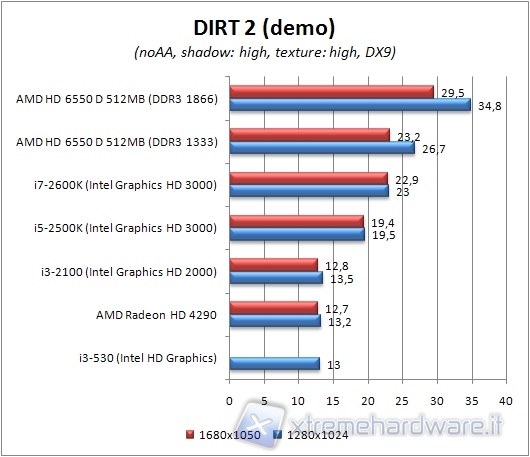
Even on this occasion, the Radeon HD 6550D proves much faster than the competition, touching and surpassing the 30 frames at 1280x1024.
We notice a marked improvement by setting the memory to 1866 MHz
The HD3000 Intel solution shows a value very close to that of HD 6550D with memory set to 1333MHz.
Graphic tests: Resident Evil 5, The Last Renmant
Resident Evil 5
Resident Evil 5, known in Japan as Biohazard 5, is a game of survival horror genre, and is the eighth installment of the main Resident Evil games, is released for the PlayStation 3 and Xbox 360. The game, developed and published by Capcom is set eleven years after the Raccoon City disaster, which occurred in 1998, and five after the adventure of Leon S. Kennedy in Spain, which took place in 2004. In 2009, Chris Redfield, former STARS member of special team, he joined a company that fights against bioterrorism, called BSAA Is sent into the heart of Africa, specifically in the region of Kijuju, to investigate a mysterious threat of bioterrorism. Li made the acquaintance of a girl, Sheva Alomar, member of the African branch of the BSAA The two soon discover the horrors of the place: the natives of Kijuju have been infected by a mysterious parasite, which sentenced them to remain in a permanent state of murderous rage. The two agents B.S.A.A. then deal with the hordes of enemies, called Majini, looking at the same time to prevent the spread of the parasite. At the same time Albert Wesker, a former captain of STARS and nemesis of Chris, he went to Africa to work with Excella Gionne, the owner of the pharmaceutical company Tricell. Wesker, helped by a mysterious hooded woman who does the dirty work for him, trying to counter the plans of the BSAA, intent on world domination.
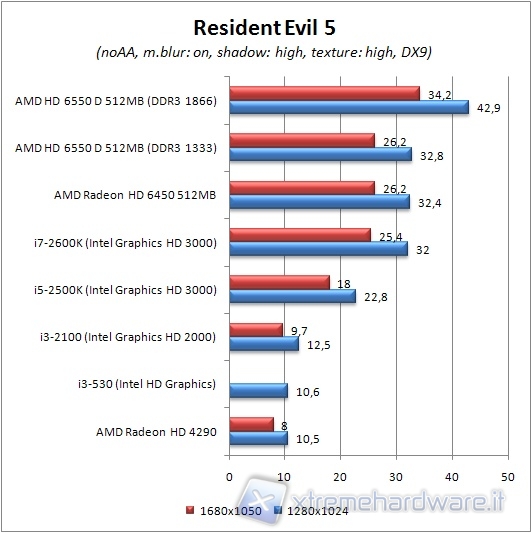
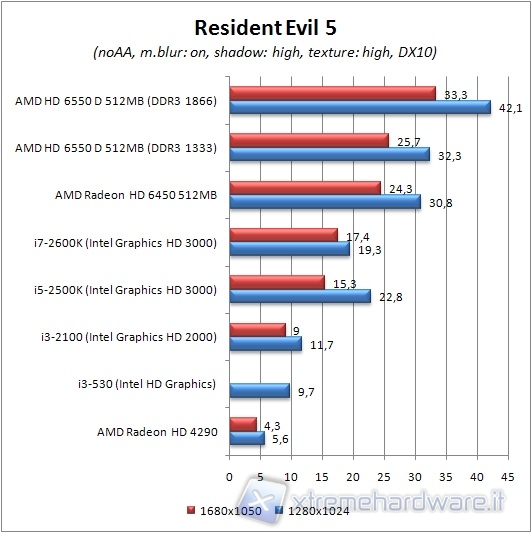
Whether using the DirectX 9 or the DirectX 10 the AMD A8-3850 integrated GPU gives very high results, in both cases exceeding 30 frames at 1680x1050, and even 40 frames at 1280x1024.
The gap with the Intel solutions is very pronounced, in fact, are almost double the performance in this case.
THE LAST RENMANT
The last born created by Square-Enix will allow the player to take the role of Rush Sykes, an eighteen year old boy waiting in spasmodic (with sister) back home to his parents, famous researchers now for years engaged in a secret project. Shortly thereafter, however, Irina (her sister) is kidnapped by shady characters who will leave unspecified what the poor Rush, who meanwhile discovered to possess a power in him, with a handful of flies. It will be the search of the beloved sister, embryonic opening words of the whole adventure, to accompany the young hero on a journey which will meet all kinds of beings, sometimes friendly and sincere at times subtle and wicked. As with any self-respecting fantasy tale characters and supporting actors are bound together, in this case by the Remnant, powerful and ancient artifact capable of turning-not without a high price to pay in-arms unspeakable power when connected to a living being after the necessary capacity.
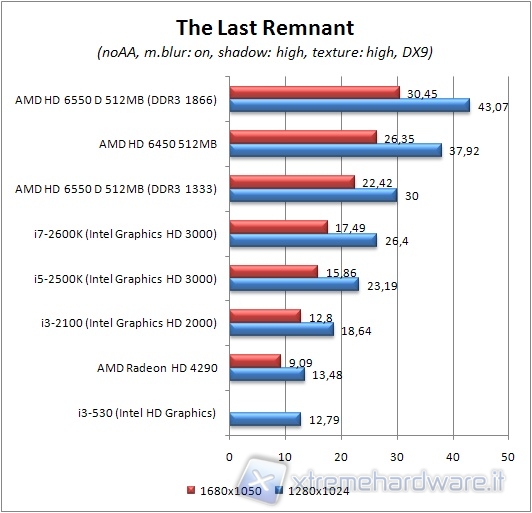
Also in this case, the AMD HD 6550D has the highest result with the RAMs set at 1866MHz. In second place we find the Radeon HD 6450 with a gap of about 4 frames at a resolution of 1680x1050. As in the previous benches Intel solutions are revealed much less efficient.
GPU Test Considerations
From the tests we noticed that the AMD A8-3850 integrated solution is much more powerful than other solutions on the market until now. With these performances we are able not only to use our PC for multimedia purposes, but also to entertain ourselves with some games. The tests results also show that the impact of the frequency of the RAM is very high, pointing out that in many cases constitute the bottleneck for graphics performance. We therefore recommend the purchase of good RAM to all those who want to get good gaming performance from this APU.
Overclock
After describing the behavior of the CPU and the GPU at standard frequency is now time to practice some overclocking.
We initially encountered some problems trying to overclock the CPU by adjusting the system bus, indeed by setting the bus just at 104 MHz we ran into an alteration of the output video that did not allow us to practice overclock if not using a dedicated VGA installed in the x16 PCI express slot.
After installing the HD 5450 we have increased in increasing steps the system bus. To check the stability of the system we have used the BurnInTest V6.0 software able to put the CPU under stress.
Here are the results achieved by increasing the bus up to 128MHz, with a dedicated video card.
3712 MHz
To achieve this rate we had to make a slight ovevolt on the CPU by setting the value of 1.5 V.
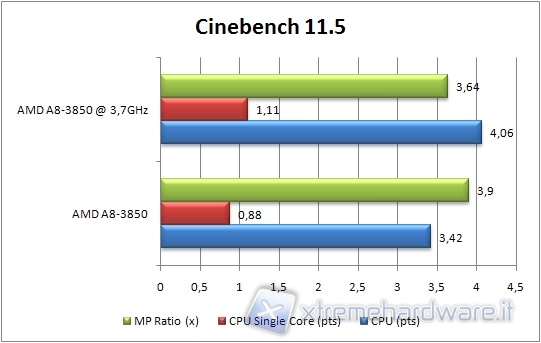
Note how at the 3.7 GHz frequency the recorded overall result is increased greatly with the Cinebench 11.5, from a result of 3.42 to 4.06.
After the CPU overclock we removed the dedicated Radeon HD 5450 and, once brought back the CPU frequency to the default, we did overclock the GPU acting only on it, managing to bring the frequency to 870MHz.
After reaching this result, we launched a 3DMark Vantage to see the benefits.
We notice a moderate increase in performance with the frequency: increasing the frequency of the GPU we get an improvement in percentage that is slightly lower to that made by the lift of the RAM from 1333 MHz to 1866 MHz
After these tests we changed the monitor and we tried again to overclock the CPU and GPU at the same time. The result was positive, in fact we found no more the problem of video malfunction, probably due to interference due to overclocking the other monitor was unable to filter.
Here is the CPU overclocking results achieved through the modification of the bus, using the integrated GPU.
Below we reports overclocking done both on the CPU and on the integrated GPU, increased to 870MHz.
Temperatures and consumption
We tried to measure the temperatures of the new AMD A8-3850 using both the CPUID HWMonitor software, and the software bundled with the motherboard, EasyTune 6; in both cases, the reported temperatures were 52 °C for the IDLE system and 53 °C for the system at full load.
This occurred at both standard frequency and overclocking, as the last image displayed on the previous page. This makes us think that current software is not yet able to detect the correct temperature of the system. We will update the data as software that can detect the proper temperatures become available.
A very interesting aspect of this new platform are the power consumption. Through a power meter we have recorded consumption value of the entire system both in idle, with the CPU under stress and in the field of gaming. Here are the values found.
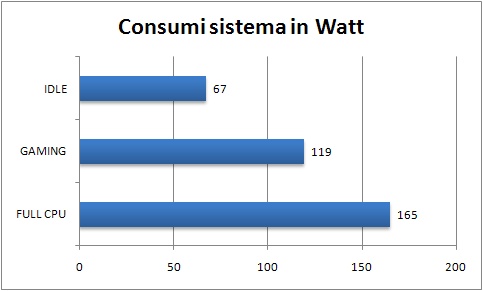
Note how in the field of gaming, consumption of the entire system is very balanced and low, reaching peaks of just 119W; a quite exciting result. In the CPU load sessions, however, the system consumes 165W, a standard value.
Conclusions

| Performance: | |
| Quality/Price: | |
| Overall: |
The new AMD A-Series solutions in this case and particularly A8-3850 CPU appear to be very balanced and a good purchase for those who need explosive performance by the CPU or GPU.
In tests the A8-3850 CPU has certainly not shone over previous AMD solutions or the current Intel solutions, which could detract from the purchase many potential users. Once passed to the GPU tests, however, we recorded very good data showing the true potential of this APU, evident especially in the graphics. At a price of € 129.99 you can buy a processor with reasonable performance, but at the same time also an excellent integrated GPU, which can give you some satisfaction even in video games.
Very important aspect comes from consumption, which are also very balanced, in fact, the consumption recorded in the field of gaming is excellent, less than 120W.
In conclusion, the new AMD architecture is, in our opinion, successful, since it allows to the average user to use the PC in all areas, without suffering from any particular limitations. The aggressively priced A75 motherboards and the now low cost of DDR3 RAM, allows you to assemble a complete platform, balanced and equipped with the latest technology at a very low price.
Pros:
· Low price
· Balanced consumption
· GPU performance
· Balanced Performance
Cons:
· CPU performance is not brilliant
We thank AMD for the sample supplied to us.
Angelo Ciardiello, and the whole gang of XH!
Translated by Marco Comerci
|
Performance: |



